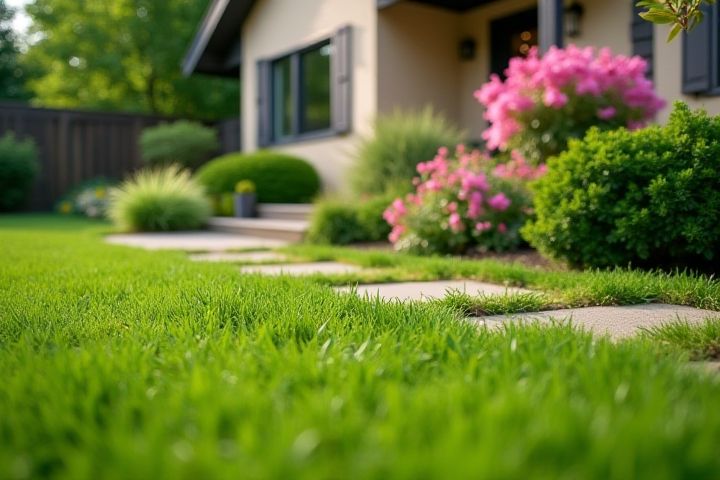
Start by assessing your yard's layout and identifying areas that need improvement. Choose native plants and ground covers, which require less water and maintenance, ensuring lower long-term costs. Implement hardscaping elements using budget-friendly materials such as gravel, stones, or reclaimed wood to create pathways and borders. Incorporate DIY projects, like building raised garden beds or creating a compost area, to enhance functionality without breaking the bank. Finally, consider adding outdoor lighting with solar-powered fixtures to create ambiance while saving on electricity costs.
How To Landscape A House Yard Cheaply
Plan and design layout.
Start with a clear plan that outlines specific zones in your yard, such as a seating area, flower bed, or vegetable garden, using free online design tools or apps to visualize your layout. Consider incorporating native plants, which not only thrive in your climate but also require less water and maintenance, saving you money long-term. Utilize mulch or gravel for pathways to reduce lawn area while minimizing weeding and mowing costs. Lastly, repurpose materials like wood pallets or stones from your property for raised beds or garden borders, creating an attractive landscape without significant expenditure.
Utilize native plants.
Utilizing native plants in your yard can significantly reduce landscaping costs and promote environmental sustainability. Native plants are well-adapted to local soil and climate conditions, which means they require less water and maintenance--saving you valuable time and resources. For instance, incorporating species such as purple coneflower or black-eyed Susan can enhance biodiversity while attracting beneficial pollinators like bees and butterflies. By choosing native plants, you can create a vibrant landscape that thrives naturally, ensuring your yard looks beautiful year-round without breaking the bank.
Use seeds over sod.
Using seeds over sod can significantly reduce your landscaping costs while promoting a more natural growth process in your yard. With seeds, you can choose from a variety of grass types suited to your climate, potentially saving you 50% or more compared to laying sod. Planting grass seed not only allows for a wider selection but also encourages beneficial microbe activity in the soil, which enhances growth and durability. To optimize your budget, consider buying seeds in bulk and preparing the soil yourself, prioritizing proper watering to ensure a successful establishment.
Build DIY garden paths.
Building DIY garden paths can enhance your yard's aesthetic appeal while keeping costs low. Start by selecting inexpensive materials such as gravel, wood chips, or repurposed bricks--these options typically range from $1 to $3 per square foot. To create a simple path, outline your desired route with stakes and rope, then clear any grass or debris, leveling the ground as needed. Once your base is prepared, fill the defined area with your chosen material, ensuring a smooth and even surface that invites exploration while improving drainage.
Repurpose materials.
Repurposing materials can significantly reduce landscaping costs while adding unique charm to your yard. For example, old pallets can be transformed into raised garden beds or creative seating areas, providing both functionality and visual interest. You can also use reclaimed bricks or stones to create pathways or borders, enhancing the aesthetics of your outdoor space without the expense of new materials. Consider using leftover paint or sealant from past projects to refresh and protect wooden features, ensuring your landscape remains vibrant and inviting.
Install mulch for ground cover.
Installing mulch as a ground cover is an effective and budget-friendly landscaping option for your yard. Utilizing materials like shredded bark, wood chips, or straw can cost around $2 to $6 per bag, covering approximately 2 to 3 square feet per bag. A 3-inch layer of mulch helps suppress weeds, retain soil moisture, and moderate soil temperature, benefiting plant health. To maximize savings, consider sourcing mulch from local landscaping suppliers or even recycling organic waste from your yard.
Incorporate container gardening.
Incorporating container gardening offers a cost-effective way to enhance your house yard while maximizing space. By using recycled materials like old buckets, wooden crates, or terracotta pots, you can create unique displays without breaking the bank. Select a variety of plants such as herbs, flowers, or vegetables that thrive in your climate, allowing you to customize your garden according to your preferences. Efficiently arrange your containers on patios, porches, or walkways to create visually appealing pathways and focal points, transforming your outdoor area into a vibrant sanctuary.
Embrace vertical planting.
Embracing vertical planting is a cost-effective way to enhance your yard's aesthetic and maximize space. You can utilize trellises, wall planters, and hanging pots to create a lush environment without extensive ground coverage. Opt for climbing plants like cucumbers or flowering vines, which provide beauty and, in some cases, edible yields, promoting sustainability. Incorporating repurposed materials, like old pallets or wooden crates, can further reduce costs while adding a unique touch to your garden design.
Implement rainwater collection.
Implementing rainwater collection is a cost-effective way to enhance landscape sustainability around your home. Install a rain barrel or cistern to capture runoff from your roof, which can be used for irrigation, cooling, or even fountain features in your garden. Incorporating permeable paving and native plants alongside your rainwater system creates an eco-friendly environment while reducing water bills. By utilizing these strategies, you can transform your yard into a thriving, low-maintenance oasis.
Choose perennial over annual plants.
Choosing perennial plants can significantly enhance your yard's aesthetic while saving money in the long run. Perennials, which can last for three years or more, often require less maintenance and lower irrigation costs compared to annuals that need to be replanted each year. For a cost-effective landscape, consider native perennials, which typically thrive in your local climate, reducing the need for fertilizers and pesticides. Investing in well-established perennial plants can yield vibrant blooms and lush foliage year after year, offering you a stunning yard without breaking the bank.
